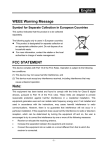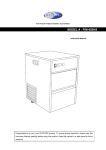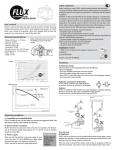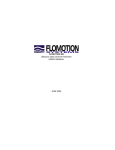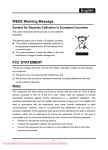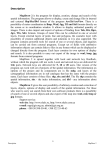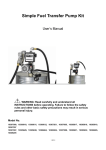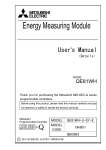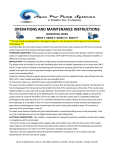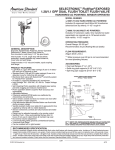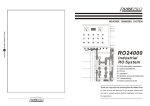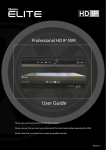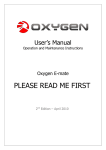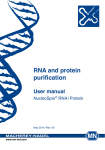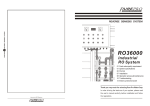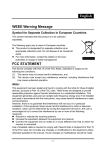Download pg. 1 100316 - Better Water Industries Inc
Transcript
pg. 1 100316 V4 Better Water Industries, Inc. Better Water Industries Inc. (BWI) established a culture in 1986. That culture has remained a mainstay of the company, from the early stages, through the company's growth, and in our vision of the future. BWI takes a strong interest in our clients by providing not only exceptional equipment, but also the knowledge and tools for their companies to succeed. We pride ourselves on loyalty and customer service, along with having a strong and incomparable network of contacts that can assist in any application within the water conditioning business. The culture is simple: we are small enough to care, but large enough to provide exceptional service. BWI has set itself apart in the industry, as we are capable of complimenting a large number and variety of clients and the equipment they sell, while still maintaining a personal touch. We believe in the old adage that our handshake and our word are firm, and we believe that is something that, unfortunately, has been lost in today's business environment. We thank our existing clientele, and look forward to new business opportunities as well. Please contact Better Water Industries, Inc. for more information, and begin to experience what a business culture and experience should be. 209 North Tyler St. Tyler, MN 56178 Phone: 507-247-5929 Fax: 507-247-3416 E-mail: [email protected] Web: www.betterwaterind.com pg. 2 100316 V4 Table of Contents Sentry I Dry Pellet Chlorinator Page# Installation & Preparation .......................................................................................... PG-4 Preparing the Well ........................................................................................ PG-4 Wire & Vent Kit ........................................................................................... PG-5 Standard Wire & Vent Kit ............................................................................ PG-5 Vermin – Proof Wire & Vent Kit .................................................................. PG-5 Attaching the Bracket ................................................................................... PG-6 Lining up the Drop Tube .............................................................................. PG-6 Wiring of your Sentry I ................................................................................ PG-6 Important Wiring Schematic ........................................................................ PG-7 Setting the Chlorinator ............................................................................................... PG-8 Chlorine Demand Calculations ...................................................................... PG-8 Determining Pump Production ...................................................................... PG-8 Chlorinator Pellet Gear Settings .................................................................... PG-9 Table 1: Ten Tooth Gear Set ......................................................................... PG-9 Table 2: Pellet Gear Setting ........................................................................... PG-9 Finishing Touches..................................................................................................... PG-10 Enlarged Parts List.................................................................................................... PG-10 Maintenance & Repair of the Chlorinator ................................................................ PG-11 Removing a motor gear ............................................................................... PG-11 Changing the motor on a Chlorinator .......................................................... PG-11 Tips for installing and service ..................................................................... PG-11 Preventive Maintenance .............................................................................. PG-11 Recirculation Check Valve & Basket Installation .................................................... PG-12 Commercial Chlorinator Specifications ................................................................... PG-12 Commercial Chlorinator ........................................................................................... PG-13 Water Volume & Contact Time................................................................................ PG-14 Sentry I Pellet Chlorinator on a Storage Tank .......................................................... PG-15 Suggested Filtration .................................................................................................. PG-16 Multi-Media Carbon Filter .......................................................................... PG-16 Multi-Media Non-Carbon Filter .................................................................. PG-16 Sentry I Open-Air Systems Open-Air Installation ................................................................................................ PG-17 Open-Air Summary ..................................................................................... PG-18 Conventional Layout ................................................................................... PG-18 Open-Air Wiring Diagram........................................................................................ PG-19 Open-Air Specifications ........................................................................................... PG-20 Scheduled Maintenance ............................................................................................ PG-20 Open-Air Parts List................................................................................................... PG-21 Flow Meter ............................................................................................................... PG-22 Trouble Tree ............................................................................................................. PG-23 Test Survey ............................................................................................................... PG-26 System Notes ............................................................................................................ PG-27 Warranty ................................................................................................................... PG-28 pg. 3 100316 V4 Installation & Preparation for Sentry I Chlorinator Better Water Industries, Inc., recommends that you have the proper tools handy that are necessary to install the Sentry I. Tools included are: Flashlight 10’ 3/4” CPVC 1 3/8” Hole Saw 5/16” Nut Driver Electrical Tape Mirror Tape Measure Channel Locks ½” Wrench **Wire Vent Kit** (Sold Separately) 9/16” Wrench Hacksaw Pliers ½” Drill Hose Clamp Rubber Hammer Screwdriver 2 Wire Nuts 7/8” Hole Saw Before installing your Sentry I, BWI, Inc. Recommends that you work closely with your State agency as approval may be necessary. Preparing the Well The following should be used when either preparing the well for installation or preparing the well in the event that the SENTRY I hasn’t been in use for more than 30 days. When you remove the sanitary seal well cap use a mirror or flashlight and see what kind of pit less adapter there is in the well. Slide the tapered end of the drop tube past the pit less adapter before dropping any pellets. Be careful so the drop tube doesn’t slip or fall down the well. Drop 15-25 chlorine pellets down the ¾” x 10’ CPVC drop tube to help satisfy the initial chlorine demand of the well. When dropping pellets ensure you hear the sounds of “PLUNK” this will ensure that the pellets have a clear passage to the water. NOTE: Predrilled, tapered-end drop tubes are used to promote moisture release, prevent pellet clogging and help with the installation past the pit less adapter. Taper the drop tubes by using a hacksaw and cutting one end of the tube in a “V” shape about 1 – ½ long. Next, drill ¼” holes in the bottom 2/3rds of the tube approximately 4” apart making sure there are no plastic shavings on the inside which might stop the pellet from dropping through. Drill all the way through the tubes so each drilling motion creates two holes. Most dealers’ inventory pre-drilled and pre-cut tubes to save installation time. Note: High static water levels (20’ or less) require a drop tube without any holes drilled in it. In this application the drop tube should be submerged one (1ft) in the water. pg. 4 100316 V4 Wire & Vent Kit Installation Type 1: Standard Wire & Vent Kit Part# M 120005 There are two ways to do this. You can either drill three holes (one for the drop tube, one for the electrical connection, and one for the vent) or drill one hole and use BWI's Wire and Vent Kit. BWI recommends using the Wire and Vent Kit and drilling a single hole. We recommend this because it is important to have adequate venting with each installation. This speeds up the installation time and gives the installation a professional look. Remove the well cap when drilling and place it on the ground and drill straight down into the cap with a 1-3/8" hole saw. This hole should line up with the hole in the pitless adapter so that the chlorine tablets will have a straight drop to the water in the well. Drill straight down, slightly off the middle of the cap. You will get a "feel" as to where to drill the hole as you install more Sentry I's. Make sure that the hole is drilled straight and not at an angle -- as this will help with the alignment of the Wire and Vent Kit and Drop Tube. For your first few installations, you may want to line up the hole by attaching the bracket before you start to drill. Install the Sentry I from the well casing up to the Sentry I system. After a few installations you will know by the sight as to where the single hole should be drilled. Type 2: Vermin – Proof Part# M 120019 When installing the Sentry I with the pre-drilled, vermin-proof, water-tight cap with the 1-1/4" threaded hole, use the Sentry I Wire and Vent Kit. We recommend this because it is important to have adequate venting with each installation. A minimum additional vent surface area of .75 square inches is provided with the Sentry I Wire and Venting Kit itself. This must be used in the installation. In all cases the well cap being used must be an approved sanitary seal or an approved vermin-proof, water-tight cap. In many applications this cap is necessary and can be ordered from BWI. pg. 5 100316 V4 Attaching the Bracket Place the two casing adapters around the well casing. You will notice that the casing adapters are sized to fit perfectly around a 4" well casing. For larger size casings use your rubber hammer to "shape" the casing adapter to the arc of that particular well casing. Included with the Sentry I are two 18" pieces of 2000# tensile strength strapping. Measure the strapping between the eyelets of the casing adapter once you have fitted the casing adapter around the well casing. Add 2 inches to the length between the eyelets and cut off the excess strapping. Bend the strapping with pliers one inch from each end of the strapping. Place the strapping in each eyelet with the 1" bend facing the well casing (on the inside) and tighten snug the bolts on the casing adapter. You will be able to put the standpipe in the casing adapter and be able to "swing" the entire adapter assembly around the well if necessary. (It is important to line up the drop tube straight down through the well casing as it extends from the bottom plate. Final tightening shouldn't be done until the bottom plate is attached). Lining up the Drop Tube Place the Sentry I bottom plate on the standpipe and turn the bracket so that the drop tube extends through the hole in the "T" of BWI's Wire and Vent Kit and into the hole on the underside of the bottom plate. It is important to have a straight drop into the well. Make sure the Sentry I bottom plate is pushed all the way on the standpipe. Once it is on the standpipe, tighten the hose clamp over the fitting that covers the standpipe with a 5/16" nut driver. Bolt the 3" bolts into the casing adapter on the inside--tightening the casing adapter around the well casing. Snug the bolts up good and tight. You should NOT be able to move the casing adapter at this point. Wiring of your Sentry I Better Water Industries, Inc. recommends that a LICENSED ELECTRICIAN make the electrical connections. The Sentry I is available in both 115V and 230V to match the voltage of the pump. When arriving at the job site make sure that you have the right voltage Sentry I with you. Motors are interchangeable between the 115V and 230V and can be ordered separately from BWI. In most instances, a Sentry I system can be installed in less than an hour....providing you have the proper tools. Note: As a preventive measure against moisture, seal conduit with caulk. pg. 6 100316 V4 IMPORTANT MAKE SURE THE ELECTRICITY IS OFF TO THE PUMP BEFORE STARTING YOUR INSTALLATION! The Electrical Connection Remove the motor cover on the bottom of the bottom plate for access to the wires. Connect the wires from the BWI Wire and Vent Kit to the wires on the motor with the wire nuts and ensure a good connection. Put the conduit fitting in the hole of the motor cover and tighten. Pull the wires out of the well and tie in the wires from BWI's Wire and Vent Kit to the wires on the pump. (Generally, you will find red, black, and yellow wires. Red is normally the starter wire that is tied into the capacitor. Usually you will use the black and yellow wires for a 230V application. Variable Frequency Drives (VFD) application must follow additional installation instructions listed below.) Connect the well pump wires to the conduit wires on the Sentry I. Again, make sure the connection is secure. Place the wires back in the well casing. Replace the well cap. Make sure the switch is in the "on" position and run water until the pumps runs. The motor gear should turn. Be sure the drop tube is securely inserted in the drop tube hole on the bottom plate. You may want to drop another chlorine pellet to make sure the pellet is reaching the water. Applications that use VFD’s (constant pressure pumps) must trigger the Sentry I with a current switch (part # M 120150). This application requires the use of a 115 VAC/60 Hz Sentry I and clean power source with the adjustable current switch clamped around one wire that drives the well pump. After wiring the Sentry I, flow water at a typical usage rate and adjust the current switch to activate or close the switch. Applications that continuously operate the Sentry I for more than one hour need to install a recycling timer and should install the commercial motor plate. BWI also has an “Accu-Dose” timer for applications where external dose adjustment is desired. (See page PG –12 & PG –13) pg. 7 100316 V4 Setting the Sentry I • As a rule of thumb, just one chlorine pellet (1 gram) will normally treat 30 gallons of water. This "30 gallon figure" is based on "trial and error" field testing over a five year period and is by no means absolute. Each application can vary and the rule of thumb may not apply. • For a more accurate setting one can figure out the chlorine demand of the water. Chlorine Demand Calculations To figure out how many gallons are treated for your specific application you need to know these specifics: 0.6 ppm of chlorine is needed to treat 1 ppm of Iron 3.0 ppm of chlorine is needed to treat 1 ppm of Sulphur 1.2 ppm of chlorine is needed to treat 1 ppm of Manganese 1-3 ppm of chlorine is needed to treat 1 ppm of Alga Bacteria Example: NOT all water corresponds to the thirty (30) gallon/per/pellet figure. Below is an example. 4ppm iron 2ppm sulphur 3ppm manganese 3ppm iron bacteria algae 2ppm chlorine (for residual) Total 4x0.6 2x3 3x1.2 3x2 2 = 2.4ppm chlorine demand = 6.0ppm chlorine demand = 3.6ppm chlorine demand = 6.0ppm chlorine demand = 2.0ppm chlorine demand = 20.0ppm chlorine demand NOTE: Chlorine demand plus chlorine residual = chlorine dosage Each 1 gram tablet contains 180ppm available chlorine. 180 ÷ chlorine demand = gallons treated In the above example - 180 ÷ 20.0 = 9 gallons/tablet Determining Pump Production If the Sentry I Flow Meter is not being used, use the following formula to determine pump rate. To determine pump rate: 1. Run water until pump starts. 2. Allow pump to run until it stops. 3. Measure water by gallon until the pump starts again. 4. Time pump until it stops. This is the formula for determining the amount of gallons the pump is producing that determines your pump rate: _________ gallons ÷ _________ seconds x 60 = _______ gpm- (In step 3) (In step 4) Note: Pumping time must be measured in seconds-NOT minutes pg. 8 100316 V4 Sentry I Pellet Gear Settings Table 1: Ten Tooth Gear Set: Drop – Rate Plugs Removed 1 2 3 4 5 6 10 12 15 20 30 60 3:1 Gear Ratio 21 MIN. 10 MIN. 30 SEC. 7 MIN. 5 MIN. 15 SEC. 4 MIN. 12 SEC. 3 MIN. 30 SEC. 2 MIN. 6 SEC. 1 MIN. 45 SEC. 1 MIN. 24 SEC. 1 MIN. 5 SEC. 42 SEC. 21 SEC. Pump Rate Gallons – Per Min Settings A B C D E F G H I J K L Table 2: Pellet Gear Setting 3 5 7 8 9 10 12 15 20 25 35 50 10 F G I I J J J K K L L L Gallons Per Tablet 20 30 C B D C F E G F G F G F H G I G J H K I K J L K 40 B C D D E E F G G H I J 50 A B C C D D E F G G I J pg. 9 100316 V4 Finishing Touches 1) Turn on the electricity to the pump and turn the switch on the motor cover to "ON" and make sure the motor drive gear and idler gear move. 2) Snap the top plate onto the middle plate making sure the tabs are in place while only using finger tight fastening on the PVC nut & washer. a. If you haven't put the 5 or 10 pound jar of chlorine in yet, turn the middle plate/top plate upside down and screw on the chlorine jar. b. By putting your index fingers on the two tabs on the bottom of the middle plate and lining up the hole for the motor gear, place the assembly back on the bottom plate. Make sure the two fit together without "rocking". 3) Finally, put the cover over the entire assembly and tighten it by twisting it. (Note: The Sentry I label should be on the same side as the drop tube) Your Sentry I is now ready for operation. Make sure that the switch is in the "ON" position. Before leaving the installation and turning on the Sentry I, make sure the entire installation is watertight and vermin proof. If the installation does not meet these criteria, it will not be approved by some states. BWI recommends purchasing NSF listed and 70% active chlorine from your Sentry I dealer. If your dealer cannot provide you with this product, please call BWI at 507-247-5929 for assistance. Exploded Parts List Number 1 2 3 4 5 6 7 8 9 9 10 11 12 12 13 14 15 16 17 18 19 20 21 Quantity 1 1 1 1 60 1 1 1 1 1 2 1 1 1 3 1 1 1 1 2 2 1 1 Part Number S-124701 S-124702 S-124703 S-124704 S-124705 S-124706 S-124707 S-124708 S-124709 S-124709C S-124710 S-124711 S-1247121 S-1247122 S-124713 S-124714 S-124715 S-124716 S-124717 S-124718 S-124719 S-124720 S-124721 Description Cover Pellet Jar Cover Seal Top Plate Pellet Plugs Pellet Gear Middle Plate Idler Gear Motor Gear Commercial Grade Motor Gear Motor Gear Seals Bottom Plate 110V. Motor Only 220V. Motor Only Motor Screws Motor Cover Switch Fuse Holder PVC Nut & Washer Casing Adapter Casing Banding Bolt Pack Assembly Motor Shaft Seal pg. 10 100316 V4 Maintenance & Repair Removing a motor gear Removing the motor gear is very simple. This should not be necessary to remove, unless you are changing the motor on the SENTRY I. First, get two (2) screwdrivers and place one on each side of the motor gear. Pry the motor gear up and off. You will notice that there are two motor gear seals still attached to the underside of the motor gear. With your screwdriver, remove the motor gear seals. When reinstalling the motor gear, install the seals first by placing it in the space in the bottom plate and ensure you place a small amount of silicone onto the seals. Insert the seal with the cup side down – the flat side up. Make sure it is firmly in place before placing the motor gear over the motor. When placing the motor gear over the motor shaft, make sure that the “T” on the shaft slides down through the corresponding space on the motor gear. Hand tighten so that it slides down all the way. Changing the motor on the Sentry I Remove the motor gear. (See above directions). Unscrew the motor cover screw with a screwdriver and remove the motor cover. You will now be able to change motors or replace the fuse. You will see that the motor is held in by three (3) motor screws. Remove those three (3) screws and pull out the motor. When reassembling makes sure that the fuse is in place and that the wire nuts are securely fastened to the electrical connection. Tips for Installing and Servicing the Sentry I 1.) Tipping the pellet jar, top plate and middle plate assembly upside down makes it simple to change the pellet jar. 2.) Tightening the 5/16” pvc nut on the underside of the middle plate will insure that the Sentry I gives you trouble free operation. Careful – over tightening will bind the pellet gear. 3.) Before replacing and tightening the cover, make sure that all plates fit securely together and are ready for operation. 4.) Make sure the switch is “ON” when leaving your customer. Also, double check to make sure the pellets are dropping unobstructed into the well. 5.) Do NOT cut a hole in the pellet jar. 6.) The Sentry I cover must always be secured and properly sealed. Preventive Maintenance • • Lubricate the motor on a annual basis with a three (3) to one (1) oil (Do NOT use WD-40) Check pellet gear for chalk build – up and clean if necessary (ensure pellet gear is DRY before inserting the pellet gear back into the unit.) Notes • • • • Store chlorine pellets in a cool, dry place out of direct sunlight Avoid chlorine pellet fumes If for some reason you disconnect the Sentry I for a extended period of time, remove the pellets and place them in storage. Rotate stock on chlorine pellets. It is recommended to use tablets within a one year time frame. pg. 11 100316 V4 Re-circulating Check Valve & Basket Installation Water Level ¼” MPT Plastic Pipe Plug with 5/64” Diameter Hole. Plug Discharges ½ to ¾ GPM. Check Valve 18’ Plastic Screen 2’ The 1” basket option is designed to distribute chlorine close to the pump inlet. Pump 4” Well Casing SENTRY I Commercial Chlorinator Specifications Accu-Dose Timer Adjustment Knob 1% - 100% Run Time SETTING PLUGS REMOVED A B C D E F G H I J K L 1 2 3 4 5 6 10 12 15 20 30 60 TIME IN-BETWEEN PELLET DROPS 16 Tooth Motor Gear 10 Tooth Motor Gear Set 100% 50% 100% 50% 4min 40sec 9min 20sec 21min 42min 2min 20sec 4min 40sec 10min 30sec 21min 1min 0sec 3min 6sec 7min 14min 1min 10sec 2min 20sec 5min 15sec 10min 30sec 56 sec 1min 52sec 4min 12sec 8min 24sec 47 sec 1min 33sec 3min 30sec 7min 28 sec 56 sec 2min 6sec 4min 12sec 23 sec 47 sec 1min 45sec 3min 30sec 19 sec 37 sec 1min 24sec 2min 48sec 14 sec 28 sec 1min 5sec 2min 10sec 9 sec 19 sec 42 sec 1min 24sec 4.7 sec 9 sec 21 sec 42 sec pg. 12 100316 V4 Chlorinator Options The Sentry I Commercial Chlorinator is based on the technology of Better Water Industries, Inc. of Tyler, MN. BWI has the experience with this technology in both residential and commercial applications nationwide. Sentry I Cover – Part # S 124701 Compatible with our 5 & 10 pound capacity jars. Commercial Cover - Part# S 124701C Compatible with the high capacity hopper and reduces internal heat due to sun exposure 5# Jar - Part# CP 22005 10# Jar - Part# CP 22010 Utilized during low to high chlorine consumption (Capacity based on six month usage or less) 25# Jar - Part# CP 22925 Optimized for maximum chlorine capacity (Requires commercial cover) Commercial Motor Gear - Part# S 124709C Delivers a maximum feed rate up to one tablet Every 4.7 seconds Motor Gear -Part# S 124709 Idler Gear - Part# S 124708 Designed for low (21 minute) drop rates to high (21 seconds) drop rates Recycling Timer - Part# M 120141 Provides cost-effective cooling for extended operating cycles Accu-Dose Timer - Part# M 120130 Provides external adjustments and cooling during long run cycles Commercial Motor Plate - Part# S124724 Reduces excess heat and strengthens motor mounting Current Sensor Switch - Part# M 120150 Operates 110 volt chlorinators with adjustable current sensitivity (used exclusively with 110 volt chlorinators during VFD applications which require “Clean” 60 Hz ) Voltage Plate Current Switch SENTRY I Cover Jar Gear Time S 1-Regular 1-5# 1–Two (2) Gear set N–None 1–110V 1–No 1–No 2-Commercial 2-10# 2-Commercial Gear A–Accu – Dose * 2 2–220V 2-Yes 2–Yes *3 3–25# *1 R–Recycling 1*. Requires Commercial Cover *2. Provides External Adjustments *3. Requires 110V Chlorinator pg. 13 100316 V4 Water Volume & Contact Time Diameter of Well 1-1 1/4" 2" 3" 4" 5" 6" 8" 10" 12" 14" 16" 18" 20" 24' 30" 36" Diameter of Tank Hole Capacity Gal. per Linear Ft. 0.1 0.2 0.4 0.7 1.1 1.5 2.6 4.1 5.9 8 10.5 13.2 16.3 23.5 36.7 52.9 Gallons per Ft. of Height Example 1 ppm 2 ppm 6 6 200 200 80 80 120 120 180 180 15 15 20 x15 = 300 - 180 = 120 10 x15 = 150 - 180 =0 Casing Size Depth of Well (ft) Static Water Level Ft. of Water in casing Gallons of water in casing Pump flow rate (gpm) 1ppm Chlorine (20 min contact time) 2ppm Chlorine (10 min contact time) X Pump Flow Rate (gpm) = Gallons of water needed for proper contact time = Gallons of water in the well = Retention tank size needed for proper contact time Note: The above chart can also be used to determine the dimensions of the retention tank. pg. 14 100316 V4 Sentry I on a Storage Tank 1) Basket must be mounted by incoming water. (Helping tablets to dissolve) 2) Drop Tube (3/4” CPVC) must be below minimum water line. 3) Chlorinator should be wired to well pump OR the chlorinator should be wired to the fill float if it is elec- trical. (When the tanks receive water the chlorinator should be running.) - The Sentry I can be mounted to the wall or tank. The drop tube can have forty-five (45) degree angles in it. pg. 15 100316 V4 Suggested Filtration Filters require 15 minute backwash and 10 minute down-rinse 1.5 Cubic ft / 10”x54” require 5gpm backwash and have a residential service flow-rate of 5gpm and a commercial flow-rate of 2.5~3gpm. 3 Cubic feet / 13”x54” require 8gpm backwash and have a residential service flow-rate of 10gpm and a commercial flow-rate of 5gpm Typically this style filter will filter to ten micron or less and has an expected life of three to five years. pg. 16 100316 V4 Open – Air Installation Mandatory Adjustments 1) Adjust the Sentry I Chlorinator with the flow rates found in step 12. (Refer to pages PG-8, PG-9 for chlorine dosage and settings.) 2) Adjust the Air-Draw Venturi between 20 and 30psi head pressure as shown with inlet pressure gauge when the existing well pump is running. (By adjusting the Air-Draw during the well pump cycle it matches the true flow rate of the well pump.) The Air-Draw tube is the small gray tube located below the Sentry I Chlorinator. This is adjusted by loosening the gray plastic nut and slightly sliding the gray tube up and down. By moving the tube up it restricts the incoming flow rate, increases head pressure, and increases aeration. By moving the tube down it increases the incoming flow rate, decreases head pressure, and reduces aeration. 3) Adjust the fill solenoid valve to match the maximum well flow rate. While the existing well pump is running, adjust flow control knob on the solenoid clockwise until there is a slight pressure drop on the inlet pressure gauge. Optional Adjustments 1) On the 10gpm and 25gpm systems, the pressure switch may be adjusted for special applications. Refer to the pressure switch cover for instructions. (On units that do not use a constant pressure valve (CPV) the bladder tank must be charged at two (2) psi less than kick in pressure.) 2) Some applications require fine-tuning the CPV to match usage. To do this flow water at a normal constant rate and adjust the bolt on the end of the bell to desired pressure. (Factory setting is 50psi to match the 40/60psi pressure switch. It is recommended to maintain this 10psi differential.) Installation 1) Shut off water to home and remove all pressure to Open-Air System 2) Install tank plugs & blow down ball valves 3) Lubricate all union o-rings on each union and assembly inlet, outlet and by-pass. (Note: The large rubber washer is used with the brass CPV if equipped) 4) Plumb inlet water to open air (If debris is present, install a sand separator prior to the Open Air’s Inlet.) 5) Connect 3/8” pressure switch line to the two quick connectors (located on the J-box and on the ball valve assembly) 6) Install bladder tank to outlet assembly (Over tightening may cause a severe leak) 7) Place Sentry I Chlorinator on plastic stand pipe and secure the ¾” CPVC drop tube to the bottom of the chlorinator 8) Plumb additional treatment equipment after Open-Air System such as a multi-media filter 9) Plumb 1-½” overflow to adequate drain or secure a five (5) gallon pail with safety float to shut off the existing well pump or water supply 10) Plumb 2” vent tube in a naturally rising configuration from the Open-Air System (check local building codes for proper installation) Air Stripping package utilizes a minimum of 1-1/4” powered exhaust. 11) Pressurize the water system up to the Open-Air 12) Flow rate well with Sentry Flow Meter (Refer to Sentry Flow Meter literature on Page-22) 13) Energize system and perform mandatory adjustments listed above (Dedicated 20amp 110volt service or 20 amp 220 volt service is required) Note: If the pump makes a “growling” noise unplug unit immediately and draw water into pump by applying a light vacuum to an outgoing water line such as the 3/8” pressure switch line. 14) Fill Sentry I Chlorinator with appropriate chlorinating tables (One (1) gram BWI Chlorinating tablets are recommended.) 15) Check for leaks 16) Test chlorine residual two (2) days after installation. Most target residuals are between 1.5 – 2.5 ppm. pg. 17 100316 V4 Open – Air Installation Summary 1st Adjustment Slides up & down 2nd Adjustment Adjust solenoid valve one (1) psi less than the air draw INLET Insert 3/8” Tubing to the By-Pass and J-Box Test Well Flow Rate Adjust air draw between 20-30psi Vent 3rd Adjustment Test Chlorine Residual OUTLET Overflow 4th Adjustment Adjust Chlorinator to preferred specs located on PG-8 and PG-9 Threaded position for our two (2gal) bladder tank or pvc fitting for larger bladder tanks Constant Pressure Valve (CPV) Factory Preset at 50 PSI Conventional Layout pg. 18 100316 V4 Open – Air Wiring Diagram pg. 19 100316 V4 Open – Air Specifications Specifications SENTRY I (Air Stripper) Continuous Flow 10 gpm 18 gpm 25 gpm Max Flow 14 gpm 22 gpm 28 gpm Capacity 130 gal 130 gal 300 gal Voltage 115 VAC 115 VAC 230 VAC Operating Current 10 amp 10 amp 6.8 amp Max Current 12 amp 12 amp Power 1/2hp 1/2 hp 8 amp 3/4 hp Frequency 60 Hz 60 Hz 60 Hz Dimensions ( LxWxH) 43"x27"x59" 43"x27"x59" 48”x32”x76” Clearance Needed 45"x27"x65" 45"x27"x65" 50”x33”x82” AB Weight 170 lb 170 lb 215 lb Gas Reduction 200 lb 205 lb 245 lb Radon 205 lb 210 lb 250 lb 45” 45” 61” Tank Height (T) Max Vacuum Max Air Flow Voltage Operating Current Power Frequency 13 ½” 18 ½” H L SENTRY I Pellet Feed Rate (Max) Pellet Feed Rate (MIN) Pellet Storage 35" H2O 43 cfm 115 VAC 3.8 amp 1/3 hp 60 Hz T 8 Pellets per minute 1 Pellet per 21 minutes 5 or 10 lbs container W Scheduled Maintenance 1) Two (2) days after installation, the chlorine residual needs to be tested between 0.5 and 3.5ppm. (BWI recommends 1.5-2.5ppm residual) Test water from a down-stream test port; do not check residual from water dipped out of the tank. If the Sentry I Chlorinator needs adjustment, repeat this step every two (2) days until desired residual is achieved. 2) Check chlorine tablet level inside the Sentry I chlorinator every month until a refill schedule is determined. A typical house-hold consumes 8-15 lbs per year. 3) Chlorine residual should be tested at a minimum of every six (6) months or anytime any of the treatment equipment is serviced. If the Sentry I Chlorinator needs adjustment, repeat step one (1). 4) Proper float operations should be checked every six (6) months. Flow water and visually confirm proper float operation. (The unit should fill when the upper electronic float, not the mechanical ball float, drops and opens the solenoid.) 5) While checking floats, ensure the bottom of drop-tube is remaining below the water level at all times. 6) Proper pressure operation should be check every year. Flow water until pump kicks in and record pressure. Then shut water off and check kick-out pressure and record. Factory setting is 40/60psi. Note: Some water applications may require increased maintenance checks Note 2: BWI recommends professional maintenance contracts with most treatment applications that require the Sentry I Open-Air System. pg. 20 100316 V4 Open-Air Parts List 6 Number Part Number 1 BT 30002 BT 30020 BT 30033 BT 30044 2 BT 40101 3 BT 40201 4 AS 120234 5 AS 120003 6 AS 120401 7 BT 40302 8 BT 40301 9 SIC 110 OA 10 BT 21M00 BT 22M00 11 BT 21E10 BT 21E18 BT 22E25 10&11 BT 21010 BT 21018 BT 22025 12 B 400101 13 BT 40901 14 BT 50010 BT 50525 15 AS 120601 15 Description Bladder Tank 2gal. Bladder Tank 20gal. Bladder Tank 33gal. Bladder Tank 44gal. Continuous Pressure Valve (Adj) 1" Solenoid Valve 3/4" Float Valve Assembly 3/4" Air draw, Float, Basket Air Stripping Package Lower Float Upper Float 110V Chlorinator for OA 110V 1/2HP Pump Motor 220V 3/4HP Pump Motor 10GPM Pump End 18GPM Pump End 25GPM Pump End 10GPM 110V Pump & Motor 18GPM 110V Pump & Motor 25GPM 220V Pump & Motor 4" PVC Cooling Shroud 1" x 1 1/4" Check Valve FPTxMPT Tank 130 Gallon Tank 300 Gallon Exhaust Fan Kit pg. 21 100316 V4 Sentry Flow Meter 1.) Blow off debris in line before attaching Sentry Flow Meter 2.) 3.) Attach the flow meter to a hydrant or hose bib by the pressure tank. Open the hydrant or hose bib to maximum flow. Partially close the ball valve to a slow water run until the pump starts. Read the pressure gauge. psi (kick-in pressure) 4.) Open the ball valve. Read the flow meter 5.) Close the ball valve. Allow pump to run until it turns off. gpm (No-Head Pressure) Read the pressure gauge. Psi (kick-out pressure) 6.) With the pump running adjust the ball valve until the pressure gauge reads thirty (30psi.) Allow the water to run at least one (1) minute at this pressure. Read the flow meter. Use this reading in conjunction with the Sentry I sizing chart located on PG-8. It also tells you how much water is available for other appliances and equipment. gpm 7.) With the pump running adjust the ball valve until the pressure gauge shows forty (40psi.) Allow the water to run at least one (1) minute at that pressure. Read the flow meter. The difference in the thirty (30psi) reading and the forty (40psi) reading determines if the pump is in good condition. gpm The gallons per minute should not vary more than twenty-five (25) percent. The Sentry Flow Meter provides accurate flow rates of pumps from zero (0) to one-hundred (100) psi, at flow rates anywhere from four (4) to twenty-eight (28) gpm. Note: Damage to the flow meter gauge will occur if exposed to freezing temperatures for extended periods of time. Additional Value The Sentry Flow Meter is compatible and a great tool to use when providing routine maintenance on the Open-Air units. The installation kit has two (2) built in test ports that are well-suited with the Sentry Flow Meter. The 1st test port is located on the solenoid side of the unit. This port will allow you to test the well flow rate. The 2nd test port is for testing chlorine residual coming from the Open-Air unit itself as well as testing the Open-Air flow rate. The unique design was engineered after years of trying to diagnose water pressure problems in various applications. By adjusting the versatile ball-valve, the flow meter can tell you the condition of the pressure tank, pressure switch, pump and if there are any restrictions within the water line. This will help to determine if the problem is in the water pump system or in the water distribution system. Other common usages are detecting scaling in pipes in city water applications by showing low flow rates and severe pressure drops. pg. 22 100316 V4 Trouble Tree Attention: All diagnostics should be preformed within normal operated water levels. If electrical work is needed please consult a certified electrician. SYMPTOM POSSIBLE CAUSES Air-Locked Pump (New Installation or after emptying unit) SOLUTION Remove the 3/8” flex tube from the pressure switch and circulate water. (If water doesn’t circulate apply suction to the 3/8” tube to prime the pump.) Pump Loses Pressure Over Night Air-Locked Pump (Drawing the unit down too far) Pump Loses Pressure During Low-Volume Usage (showers) Air-Locked Pump (Gasses in Water such as Methane Applications) The incoming water should be greater or equal to the outgoing water. Use flow restrictor on outgoing water if needed and adjust lower float up two inches. A standard 40/60 pressure unit is needed for this application. To convert an Aqua Booster to 40/60, remove the constant pressure valve, remove the two gallon bladder tank, and add adequate sized bladder tank for unit. (10gpm use 20gal, 18gpm use 33gal, and 25gpm use 44gal) Clean wet end of pump with solvent that dissolves unwanted material. Pump will not Pump Water Coated / Fouled Impellers Large Internal Leak Low Water Pressure (Flow Test System With Flow Meter) Improperly Adjusted Constant Pressure Valve Over Pumping Faulty Wet-End No Power to Unit Faulty Pressure Switch Pump Motor not Running / Spinning Faulty / Locked Wet End Faulty Lower Float Faulty Pump Motor Shutoff out-going water. System should build up and hold pressure. If not check for internal leak or faulty check valve. Adjust constant pressure valve by flowing low to a normal amount of water. Adjust bolt on black bell housing to around 55psi on 40/60 applications. (These instructions are rule-of-thumb) Verify flow rate of system and compare with demand. Replace wet end of pump (Units before 2004 may need unit specific wet-end) Check outlet for appropriate power source Remove the gray J-box cover and inspect the pressure switch, switch contacts, and voltage at switch. (If contacts are burnt, check for dedicated adequate power source, bladder tank, and constant pressure valve if equipped.) Inspect pump end, remove screen, and manually turn the motor shaft. (should spin easily) Ohm test the low float for proper operations. The lower float is normally open in the downward position. Replace Pump Motor* *When removing the pump place a vice grip on the inside of the tank on the PVC union avoiding any crimping of wiring and then remove the constant pressure valve union and begin to unthread the PVC nipple on the top side of the tank. pg. 23 100316 V4 SYMPTOM Rapid Pump Cycling (faster than one second) POSSIBLE CAUSES Faulty Pressure Tank No Pulse Plug in Pressure Switch Faulty Pressure Tank Short Pump Cycling Unit Not Filling Unit Filling Slow (Inlet pressure gauge below 5psi) Unit Filling Slow (Inlet Pressure gauge above 5psi) Faulty Constant Pressure Valve SOLUTION Check pressure in bladder tank. (factory setting for the 2 gal tank is 28 psi and 38 psi for larger ones) ONLY used in applications with bladder tanks larger than 2 gallons. Pulse plugs are located below the 1/4" NPT thread of the pressure switch. Check pressure in bladder tank. (2 gal tanks 28 psi, larger ones 38 psi factory) Option #1: Clean, service, or replace valve. (Red and white plastic Cycle Stop valves should be replaced with the brass constant pressure valve.) Option #2: Remove valve and replace 2 gallon bladder tank with adequate sized bladder tank for system. (Systems prior to 2004 use a black "T" style constant pressure valve. Remove the spring and plastic plunger under the 1" pressure gauge plug. Then replace the 2 gallon bladder tank with adequate sized bladder tank for system.)(10gpm use 20gal, 18gpm use 33gal, and 25gpm use 44gal) Faulty Check Valve or Internal Leak Bad Wire Connection Faulty Solenoid Valve Faulty Upper Float Solenoid Valve Direction Low Incoming Water Flow / Pressure Replace solenoid only Replace entire solenoid valve Ohm test the upper float (Normally closed in down position) (If chlorinator is running when upper float is down, the float is most likely GOOD) Improperly Adjusted Safety Float Valve On new installs verify proper safety float adjustment. (Refer to installation instruction) (Electronic floats are factory set and should not need to be adjusted.) Plugged AirDraw Readjust Air-Draw tube (See installation instructions and start by tapping down the Air-Draw tube slightly) If the Air-Draw is internally coated with debris, clean by dissolving debris with a solvent. Shut off water to house, let the system build up pressure and shut off. If the unit losses pressure there is an internal leak or bad check valve. Check connections and voltages (Refer to Voltage Check cut sheet) On new installs verify flow direction of solenoid valve Check incoming water flow / pressure Check pre-filter if installed pg. 24 100316 V4 SYMPTOM POSSIBLE CAUSES Debris in Solenoid Valve Unit is Over Flowing Improperly Adjusted Float Settings Faulty Upper Float SOLUTION Clean Valve (In high turbidity water a spin-down filter or sand separator should be installed ahead of the solenoid.) On new installs verify proper safety float adjustment. (Refer to installation instruction) (Electronic float are factory set and should not need to be adjusted.) Ohm test the upper float (contact is open when float is up) (If chlorinator is running when upper float is in up position, the float is most likely BAD) Sentry I Chlorinator on Open-Air System or Holding Tank SYMPTOM 1) Broken Motor Gear 2) Intense Chlorine Smell Under Chlorinator Cover 3) Heavy Corrosion or Rust on Motor 4) Top and Middle Plate Separation 5) Moisture in Pellets 6) Heavy Chalk on Pellet Gear POSSIBLE CAUSES Drop Tube not Always in Water (Open-Air or Storage Tanks) High Static Water Level (20' or less) Faulty Cover Seal Hole in Pellet Jar Hole in Chlorinator Cover Conduit not Sealed Chlorinator Cover Removed No Power to Motor Motor not Running Armature not Turning Unit Not Full of Water Chlorinator Will NOT Shut OFF (line pressure on inlet gauge) Mechanical Float Mis Adjusted SOLUTION Drop-tube should be 24" long or always submerged in water The incoming water should be greater or equal to the outgoing water. Use flow restrictor on outgoing water if needed. Extend new Drop Tube with point in water 1' and NO holes drilled in tube Replace white foam cover seal. Replace jar Replace cover Caulk one end of conduit Install cover Check and/or replace fuse(s) Check for power on both sides of switch Check electrical connections Replace upper float (Open-Air applications) Loosen and lubricate armature with 3 in 1 oil Fill Tank With Water Adjust mechanical float up so it doesn’t shut off water during normal fill cycle. (Make sure it does shut off water in the event of an overflow.) NOTE: For proper sanitation and oxidation the pH of the water must be between 6.8 and 7.6. Failure to correct pH problems may result in unsatisfactory results and possible equipment damage. A filter is vital to the success of desired water quality. Once the Sentry I or the Sentry I Open-Air System has oxidized the contaminants in the water, they must be removed prior to entering the residence or building’s water system. Small, inline sediment filters will not work for these applications. After years of field-testing results, BWI recommends the two Multi-bed filters as described on pages PG-16 of the BWI dealer manual. The use of carbon is at the discretion of the homeowner. That decision to use the Multi-bed Filter with or without carbon depends on if the homeowner wants chlorine for continual disinfection or would prefer no chlorine residual at all. Variations from these suggested filters may affect the water quality. pg. 25 100316 V4 Test Survey I. II. III. IV. V. VI. Well: 1. Well Age yrs 2. Well Depth ft ft A. Static Water Level B. Pump Depth ft 3. Casing Size Plastic Cement A. Type: Steel Pump: 1. Age yrs Voltage Phase 2. Hp 3. Type: Jet Submersible Stroke VFD Flow Rate: 1. GPM GPD Pressure Tank: 1. Size: X Gallon 2. Type: Bladder Non-bladder Incoming Lines: 1. Size: inches. Galvanized Plastic 2. Type: Copper Lavatory: 1. Hard Water Soft Water VII. 1. Hardness gpg 2. Iron (rust) ppm Bacterial 3. pH 4. TDS ppm 5. Tannins ppm 6. Methane Yes No 7. Radon Yes 8. Nitrates ppm 9. Sulfates ppm No 10. Hydrogen Sulfide: Yes 11. Other VIII. Type of Equipment Present: 1. 2. 3. 4. Red Water Clear Water No ppm Customer Wants/Comments: Future Appointment: Date Time pg. 26 100316 V4 System Notes pg. 27 100316 V4 Warranty WE THE PEOPLE of Better Water Industries, in order to truly provide you, our CUSTOMER, with the highest quality of water, both today and tomorrow, do provide you with these LIMITED WARRANTY’S. Sentry I Open – Air System Article I: Better Water Industries, Inc. 209 North Tyler St. Tyler, MN 56178 ("BWI"), warrants and promises that its Sentry I OpenAir System is free of defects in materials and workmanship at the time the Sentry I Open-Air System leaves the factory. Article II: If a defect develops in any of the Sentry I Open-Air System, except for the chlorinator, for up to twelve (12) months from ship date, Better Water Industries, Inc. will, at its option, replace, or rebuild said defective part according to Article V. Article III: If a defect develops in chlorinator electronics for up to twenty-four (24) months from ship date, Better Water Industries, Inc. will, at its option, replace, or rebuild said defective part according to Article V. Article IV: If a defect develops in chlorinator housing or any plastics of the chlorinator for up to sixty (60) months from ship date, Better Water Industries, Inc. will, at its option, replace, or rebuild said defective part according to Article V. Article V: Section One: Return the defective part to BWI Inc. postage prepaid. Section Two: Enclose a return tag with a written description of the defect. Section Three: Also enclose a written statement assuring BWI Inc. that the product was properly installed, not misused or abused. Section Four: Replacements or Credit will be issued after BWI Inc. inspects the unit and concurs on said defect. Article VI: BWI Inc. warrants all replacement parts for ninety (90) days from date of shipment. Article VII: There are no other warranties, whether expressed or implied, which extend beyond this written warranty. Sentry I Dry – Pellet Chlorinator Article I: Better Water Industries, Inc. 209 North Tyler Street, Tyler, Minnesota 56178, warrants and promises that it’s Sentry I Chlorinator is free of defects in materials and workmanship at the time the Sentry I leaves the factory. Article II: If a defect develops in any of the electrical components for up to twenty-four (24) months from the shipment date, Better Water Industries, Inc. will, at its option, replace, repair, or rebuild the motor according to the Article IV. Article III: If a defect develops in the housing or any other parts of the Sentry I for up to sixty (60) months from shipment date, Better Water Industries, Inc. will, at its option replace, or rebuild the unit according to Article IV. Article IV: Section One: Return the defective part to BWI Inc. postage prepaid Section Two: Enclose the return tag with a written description of the defect. Section Three: Also enclose a written statement assuring BWI Inc. that the products were properly installed, not misused or abused. Section Four: Replacement or Credit will be issued after BWI Inc. inspects the unit and concurs on the said defect. Article V: BWI Inc. warrants all replacement parts for ninety (90) days from date of shipment. Sentry I Commercial Dry – Pellet Chlorinator Article I: Better Water Industries, Inc. 209 North Tyler Street, Tyler, Minnesota 56178, warrants and promises that it’s Sentry I Commercial Chlorinator is free of defects in materials and workmanship at the time the Sentry I leaves the factory. Article II: If a defect develops in any of the electrical components for up to twelve (12) months from the shipment date, Better Water Industries, Inc. will, at its option, replace, repair, or rebuild subject to the following. Article III: Section One: Return the defective part to BWI Inc. postage prepaid. Section Two: Enclose a return tag with a written description of the defect Section Three: Also enclose a written statement assuring BWI Inc. that the product was properly installed, not misused or abused. Section Four: Replacement or Credit will be issued after BWI Inc. inspects the unit and concurs with said defect. Article IV: BWI Inc. warrants all replacement parts for ninety (90) days from date of shipment. Professional installation is required for warranty. There are no other warranties, whether expressed or implied, which extend beyond this written warranty. IN WITNESS WHEREOF, I have hereunto subscribed my name: L. Burckhardt, President BWI Inc. T. Burckhardt, Vice-President BWI Inc. Copyrighted BWI Inc. 2008 BWI – We take pride in protecting your water. pg. 28 100316 V4




























